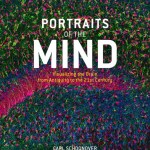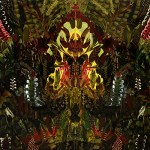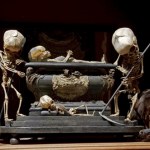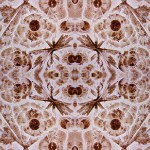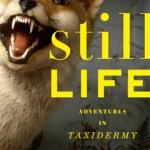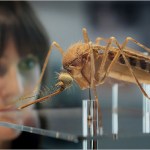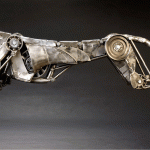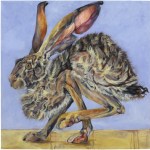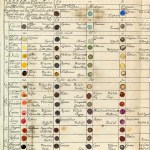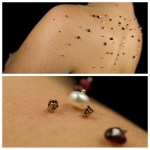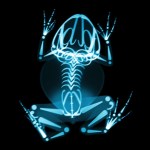Museum Lust
In less than a month (December 2nd), Christie's will auction off Edward Tufte's library - an idiosyncratic collection of first edition books, plates, prints, and ephemera that the dataviz guru calls his "Museum of Cognitive Art," and I call "Jessica's Christmas List."
I'm not going to sample low-rez images of the lots here, because there's a stunning slideshow, complete with curation, at the Christie's website. If you've got ten minutes, this is virtual antiquarian dataviz windowshopping at its best.
There appear to be 160 lots; Tufte's website describes it as "200 rare books, including major…
Hippocampus: Broad Overview
Tamily Weissman, Jeff Lichtman, and Joshua Sanes, 2005
from Portraits of the Mind: Visualizing the Brain from Antiquity to the 21st Century by Carl Schoonover
The first time I created a transgenic neuron, it was in a worm, C. elegans -- a tiny, transparent cousin of the earthworm. I injected DNA into the embryonic worm, let it grow up, and voila: there was one eerie green blotch like a little Pac-Man ghost, its long green axon a lime racing stripe running along the worm's transparent body. The worm wiggled, but I was the one hooked: science is beautiful.
You…
And now for a completely different type of glass art: this time from sculptor Luke Jerram. His deceptively beautiful glass malaria parasite (see video below) will be auctioned off to benefit Malaria No More.
Via Medical Museion. The "malaria parasite" is also known as Plasmodium falciparum. Read more about Jerram's sculpture here - no, I don't know when the auction will be, but I imagine he'll update his website with the news.
This, this and this all came close, but in the end, it took a book: a yummy new neuroscience, history of science, beauty of science, wow-brains-are-beautiful book.
The other day I heard about something that I just HAD to blog, hiatus/retirement be damned! Portraits of the Mind: Visualizing the Brain from Antiquity to the 21st Century, a new book by neurobiology PhD candidate Carl Schoonover, is coming out in a few weeks, and I'm lucky enough to have a preview copy sitting here before me.
This book encapsulates my original vision for BioE - a narrative that brings science history together…
In the New York Times, a quick article on a study in the journal Neurosurgery by two Johns Hopkins professors. The abstract argues that Michaelangelo
concealed another neuronanatomic structure in the final panel of this series, the Separation of Light From Darkness, specifically a ventral view of the brainstem. The Separation of Light From Darkness is an important panel in the Sistine Chapel iconography because it depicts the beginning of Creation and is located directly above the altar. We propose that Michelangelo, a deeply religious man and an accomplished anatomist, intended to enhance…
The God Particle, 2008
Andy Harper does amazing work with oils: fantastic gardenscapes populated with unanticipated plants. Many of his works incorporate dramatic symmetry, reminiscent of a Rorschach blot or the patters on a flowerhead.
Half Devil, Half Buccaneer
Read an interview with Andy Harper at failedrockstar.
Joanna Ebenstein of Morbid Anatomy has just unveiled a new website, the Secret Museum, to house her "exhibition of photographs exploring the poetics of hidden, untouched and curious collections from around the world." So if you can't make it to her show in NYC (through June 6), you can browse her virtual exhibition of photos - like the eerie fetal skeleton tableau above (from Paris, circa 17th century).
"Fossil geometry" (detail)
Based on Eschschottzia Californica seeds collected by Mr W Reeves, April 1864.
From the collection of the Royal Microscopic Society.
UK sci-artist Heather Barnett has created a line of wallpapers using micrographs of cells, crystals, seeds, nanofibers, etc. They'd be particularly striking in a loft or other industrially inspired space - including a lab or a clinic waiting room. Come on, PIs, you can squeeze a wallpaper budget in your next grant application, can't you?
"Fossil geometry" (repeat)
Check out more of Barnett's biological wallpapers below the fold…
This is what I miss out on by not reading the physical copy of the New York Times: ads! I recently picked up a copy of the Times science section and saw an ad for these wonderful vintage patent office models from the 1900s.
As if they're not steampunky enough, each one comes with a little yellowed, handwritten, calligraphic tag that I'm dying to read because I am convinced it must contain cryptic clues to some sort of awesome Neil Stephenson-style mystery. Right??
Here's another interesting summer reading prospect for BioE-philes: Still Life: Adventures in Taxidermy by Melissa Milgrom. From the New York Times review:
The best chapter in "Still Life" by far is the one in which Ms. Milgrom visits with the fascinating and foul-mouthed British artist Emily Mayer, the woman who is Mr. Hirst's taxidermist. She's the woman who, we learn, "repairs the sharks, preserves the grizzlies, assembles the skeletons, and casts the cow heads for his multimillion-dollar artworks." Ms. Mayer is a Tim Burtonesque perfectionist: "I can't have a piece for Damien discolor in…
Wellcome's renowned London Centre for the History of Medicine will be closed. No one quite knows why, but Thomas has been posting about this at Medical Museion and will keep us updated. There is also a news update in BMJ for those with subscription access. Note that nothing I've seen suggests that the snazzy new Wellcome Collection, also in London, is in any danger.
Photo: Peter Macdiarmid/Getty Images
There's a great article at the NYT on the Cocoon, a collection of natural specimens in London's Natural History Museum's Darwin Center. Check out the slideshow to appreciate the juxtaposition of Romanesque architecture with the space-age, egg-shaped exhibition space. Very quirky.
A very cool addition to the NLM "Turning the Pages" virtual library, which I blogged about back in December: the Edwin Smith surgical papyrus. You literally click and drag to unroll the papyrus, and then toggle the annotations on or off. While it doesn't have the pretty pictures that some of their other virtual manuscripts do (like Robert Hooke's Micrographia), it's pretty cool to unroll the world's oldest surviving surgical text, written in Egyptian script circa the 17th century BC.
(Alas, while my first instinct was "This would look so cool on the iPad," the website's in flash. Boo.)
This week at Coney Island, the first ever "Congress for Curious People" brings together historians of science, artists, taxidermists, musicologists, and all manner of. . . curious people. It's part of the larger "Congress of Curious Peoples":
Every spring Coney Island USA convenes The Congress of Curious Peoples, a 10-day gathering of unique individuals at Sideshows by the Seashore and the Coney Island Museum, celebrating Coney Island's subversive and exciting power and exploring its political, artistic, and spectacular possibilities through performances, exhibitions, and films by important…
C.B., circa 1708: "These color circles, from a 1708 edition, are the earliest published examples of Newton-style color circles in an artist's manual."
Moses Harris, 1766: "Mimicking the spread of light from a source, Harris places the pure colors at the center of his circle and the lightest at the outer edge."
Schiffermuller, 1772: "Like many others with the same goals, he assumed that there is a knowable natural order to color, one that would confirm the relationship among all forms of knowledge."
More quotes and images from Sarah Lowengard's e-book The Creation of Color in 18th Century…
I don't think I've posted yet about Andrew Chase's graceful articulated metal sculptures. His cheetah is particularly stunning.
Click the image to watch it run!
Chase's mechanical sculptures have way more personality than metal should. The soulful eyes of his elephants and giraffes could reflect some futuristic world in which extinct flesh-and-blood animals have been (inadequately) replaced with patchwork gestures at nature. Or perhaps they look lonely because they're intimidated by the flesh-and-blood inspirations of which they are ingenious, but dead, replicas.
Robot Timmy Recharging…
Jackrabbit #5
Joianne Bittle, 2009
Joianne Bittle has an awesome job (Exhibition Assistant at the American Museum of Natural History) where she gets to paint, draw and make dioramas. Wow. But she's also an accomplished artist in oil and wax, as these paintings attest. Her series of beetle paintings, A Royal Family, were the result of six years of life observation.
A Royal Family (Goliath Beetle)
Joianne Bittle, 2003
Joianne Bittle currently has work appearing in Entomologia, curated by M of Curious Expeditions! Check it out if you're in NYC - the show runs through April 4.
From Richard Waller, "A Catalogue of Simple and Mixt Colours with a Specimen of Each Colour Prefixt Its Properties"
Philosophical Transactions of the Royal Society of London, vol. 6, 1686/1687 (London, 1688)
Noting the lack of a standard for colors in natural philosophy, and inspired by a similar table published in Stockholm, Richard Waller indicated that his "Table of Physiological Colors Both Mixt and Simple" would permit unambiguous descriptions of the colors of natural bodies. To describe a plant, for example, one could compare it to the chart and use the names found there to identify…
Blooms, Efflorescence, and Other Dermatological Embellishments: Cystic Acne, Back
Lauren Kalman, 2009
Metalsmith and mixed-media artist Lauren Kalman explores the nexus of body, adornment, and disease in her remarkable series "Blooms, Efflorescence, and Other Dermatological Embellishments". Yes, those faux-diseases are actually piercing the skin - but only temporarily: they're gold acupuncture wires modified into jewelry by the artist. The temporary/permanent nature of the piercings echoes the temporary visibility of the diseases she depicts, like syphilis and herpes, which eventually clear…
Delicious - and suprisingly convincing - x-ray images of animals with "skeletons" made of typography by Katerina Orlikova. Be sure to check out _Motion Picture, a running cat-like creature reminiscent of Eadweard James Muybridge's vintage motion photography.
Via Street Anatomy.

